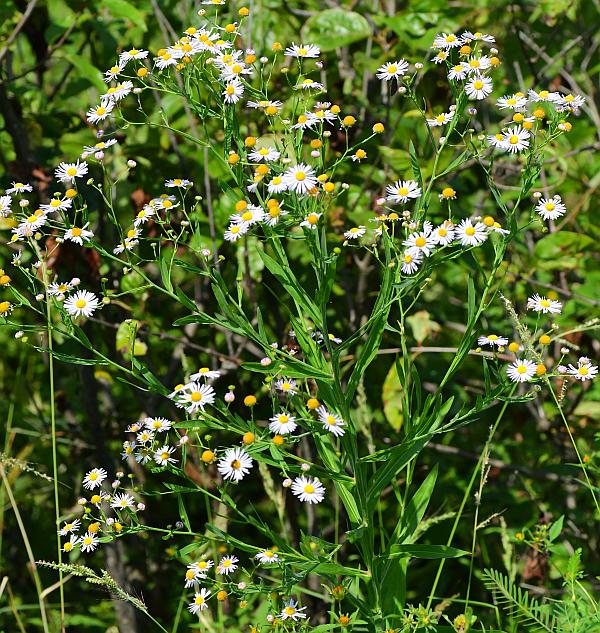Boltonia decurrens (Torr. & A. Gray) Alph. Wood
Decurrent False Aster

Native
CC = 8
CW = -5
MOC = 7
SRank = S1
© SRTurner
Boltonia decurrens (Torr. & A. Gray) Alph. WoodDecurrent False Aster | |
 |
Native CC = 8 CW = -5 MOC = 7 SRank = S1 |
© SRTurner |
|
Family - Asteraceae/Astereae Habit - Fibrous-rooted perennial forb, producing basal offshoots but no rhizomes.
Stems - Ascending to erect, to 2.5 m, usually much branched in the apical half, glabrous, prominently winged with decurrent tissue from leaf bases.
Leaves - Alternate, simple, sessile. Blades 5-20 cm long, 5-25 mm wide, those of the lower and median leaves oblanceolate to narrowly elliptic, those of the upper leaves mostly narrowly elliptic to linear-elliptic, the surfaces glabrous, the bases strongly decurrent below the attachment point as a pair of wings of green tissue along the stem ridges, the stems thus appearing irregularly winged.
Inflorescences - Leafy, open panicles of numerous heads, the heads solitary at branch tips, the branches with numerous leafy bracts, these linear-lanceolate, 0.5-5.0 cm long, 1-11 mm wide.
Heads - Radiate. Receptacle usually 6-12 mm in diameter at flowering. Involucre 3-5 mm long, the bracts in 3-5 subequal to somewhat unequal series, narrowed or tapered to a sharply pointed tip or sometimes rounded to an abrupt, short, sharp point.
Flowers - Ray florets 45-60, pistillate, the corolla 9-11 mm long, white. Disc florets 250-400, perfect, the corollas yellow. Pappus of disc florets a short, irregular crown of awns or narrow scales 0.1-0.4 mm long and 2 awns 1-2 mm long, the longer awns well developed in the disc florets, sometimes absent in the ray florets.
Fruits - Achenes 1.5-2.5 mm long, those developing from the disc florets wedge-shaped to obovate in outline, relatively strongly flattened, broadly rounded or angled to shallowly notched at the tip, the margins winged, the surface and margins often minutely hairy, tan to grayish brown with lighter wings; fruits developing from ray florets more or less wedge-shaped, 3-angled, with 3 narrow wings.
Flowering - August - October. Habitat - Riverbanks, pond margins, bottomland prairies, margins of fields, levees. Origin - Native to the U.S. Lookalikes - B. asteroides, Erigeron spp. Other info. - This species is uncommon in Missouri, and is in fact listed as endangered by both Missouri and the federal government. Its global distribution is mostly restricted to floodplain of the Illinois River and the region of the Illinois' confluence with the Mississippi River. It is an easily recognized species, defined by its large panicles of white flowering heads with yellow centers, and, especially, the distinctive flanges of green tissue which run from the leaf bases down the stem. The latter feature is what distinguishes it from the much more common B. asteroides, and also what contributes the plant's specific epithet. Photographs taken near Gilbert Lake, Jersey County, IL, 9-30-2007, and at B. K. Leach Memorial Conservation Area, Lincoln County, MO, 9-13-2021 (SRTurner). Fruiting photos by Kathy Bildner, 10-16-2024. |